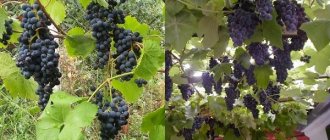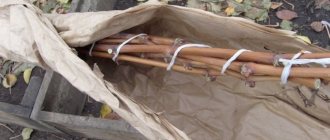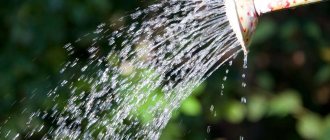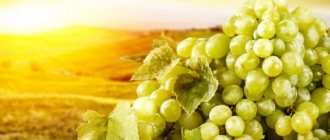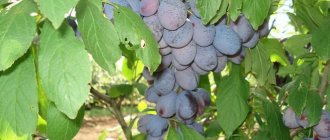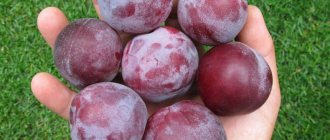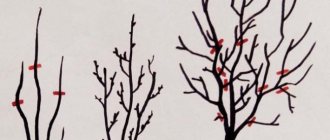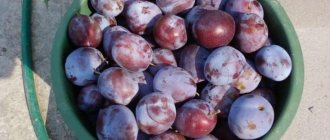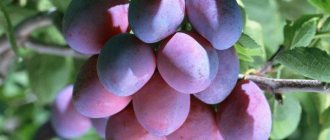Description and characteristics of Amethyst grapes
The variety belongs to the group of red varieties. The tasting score is 8.1 points. The fruits contain from 16 to 23 percent sugar, the acid is rated as medium.
The bushes are prone to intensive growth, so special rationing is required for the variety. One bunch, which develops according to the standard scenario, weighs from 600 to 900 grams. The fruits have a regular cylindrical shape, the color is uniform and rich purple.
Grapes Amethyst Novocherkassk
One of the latest developments of the All-Russian Research Institute of Viticulture and Winemaking named after Ya.I. Potapenko – Amethyst Novocherkassk variety. Its “parent pair” is “Delight” and “Delight red”. The newest hybrid form of table grapes, bred by Russian breeders, has an interesting color and a very unusual taste that can change as the berries ripen, which is its unique feature.
The variety quickly became widespread, after which the first impressions of the new hybrid began to appear. As is expected when testing new forms, reports varied, but in general, most farmers noted the attractive appearance of the bunches and the unique taste of the berries. Winegrowers from more northern regions especially liked Amethyst Novocherkassk.
Appearance
Medium-loose clusters are beautiful, large, and have a cylindrical-conical shape. Weight ranges from 500 to 800 grams. The berries are quite large - weighing from 6 to 8 grams each, and have an elongated shape. The thin, easily eaten skin hides a fleshy, juicy, crispy pulp with a pleasant, harmonious taste, which, according to experts, is a bit reminiscent of the taste of a plum. The color of the berries can change as they ripen: the spectacular dark pink berries darken slightly when overripe and acquire a dark crimson hue. Many owners of grape farms do not recommend bringing this Amethyst Novocherkassky variety to a state of overripeness.
Qualitative characteristics
Amethyst Novocherkassk is considered a hybrid of early and very early ripening. For example, in the vicinity of Novocherkassk, grapes reach ripeness by the end of July or the beginning of August. Bushes of this variety are characterized by average and above average growth vigor. The flower is bisexual. The vine ripens along almost its entire length. Most winegrowers note the increased yield of the new hybrid and its tendency to overload, which results in the need for normalization with inflorescences. The variety has proven to be quite frost-resistant - down to minus 24-25 degrees. Although it is too early to speak about final conclusions regarding susceptibility to fungal diseases, almost all farmers were pleased with the high resistance to diseases (at the level of 2.5 points) and cracking of berries. In addition, the grapes turned out to be unattractive to wasps, which is also an important advantage.
Opinions were also divided regarding the taste, but Amethyst Novocherkassk received a good tasting score - 8.1 points. The grapes gain sugar content from 15 to 23%. Acidity is 5.7 g/l. The transportability of ripened bunches is noted to be very high, which is a significant advantage for table grapes.
Features of care
The formations of grape bushes are mostly horizontal cordon or fan and depend on climatic conditions. Pruning of fruiting vines - 4-6 buds. The optimal load for this variety is considered to be from 30 to 35 eyes per bush. Due to fairly high frost resistance, grapes do not require shelter for the winter. Frequent heavy rains can cause serious damage to the plant, so it is advisable to carry out preventive spraying.
It has been noticed that the berries of the Novocherkassky Amethyst variety can hang on the bush for a long time, right up to October. At the same time, they do not deteriorate and retain their attractive appearance: they do not burst or crack. However, experienced gardeners still do not advise overbearing Amethyst Novocherkassk in order to prevent it from becoming overripe. As a result, the berries begin to gradually darken, and the color becomes ugly. Its inherent pleasant plum flavor also changes - according to some reviews, it takes on a “dried-smoked” hue.
This variety appeared on the market quite recently - at the beginning of the 21st century. In this regard, many of its qualitative characteristics are under study. But the undoubted advantages of this new hybrid form have already been noted. First of all, this is an early ripening period. Not every plant can boast of ripe berries at the end of July - almost in the middle of summer. In addition, its beautifully colored dark pink clusters and unusual taste with a hint of plum indicate its good marketability, which, combined with excellent transportability and resistance to external adverse factors, is important for table grapes.
From the above we can conclude that the hybrid form of Amethyst Novocherkassk will soon take its rightful place in the garden plots of grape lovers.
Advantages and disadvantages
The variety is designed for cultivation in the absence of temperature changes. The variety has advantages and disadvantages.
Advantages and disadvantages
Abundant Harvest
Good tasting notes
Fruits are not prone to cracking, falling, rotting
Increased frost resistance
The need to standardize inflorescences due to the ability to form an excessive number of racemes
Lack of resistance to oidium
Separately, experts emphasize such a feature as resistance to parasites. There are almost no wasps on the lash that can cause harm to the crop. This is explained by the fact that the variety is not prone to cracking, leaking juice, or attracting insects.
Expert opinion
Zarechny Maxim Valerievich
Agronomist with 12 years of experience. Our best country expert.
Ask a Question
Reference! The advantage of the variety is frost resistance. Lowering the air temperature to 0 degrees during cultivation does not affect the tasting evaluation of the fruit.
Grapes Amethyst Novocherkassk
One of the latest developments of the All-Russian Research Institute of Viticulture and Winemaking named after Ya.I. Potapenko – Amethyst Novocherkassk variety. Its “parent pair” is “Delight” and “Delight red”. The newest hybrid form of table grapes, bred by Russian breeders, has an interesting color and a very unusual taste that can change as the berries ripen, which is its unique feature.
The variety quickly became widespread, after which the first impressions of the new hybrid began to appear. As is expected when testing new forms, reports varied, but in general, most farmers noted the attractive appearance of the bunches and the unique taste of the berries. Winegrowers from more northern regions especially liked Amethyst Novocherkassk.
Appearance
Medium-loose clusters are beautiful, large, and have a cylindrical-conical shape. Weight ranges from 500 to 800 grams. The berries are quite large - weighing from 6 to 8 grams each, and have an elongated shape. The thin, easily eaten skin hides a fleshy, juicy, crispy pulp with a pleasant, harmonious taste, which, according to experts, is a bit reminiscent of the taste of a plum. The color of the berries can change as they ripen: the spectacular dark pink berries darken slightly when overripe and acquire a dark crimson hue. Many owners of grape farms do not recommend bringing this Amethyst Novocherkassky variety to a state of overripeness.
Qualitative characteristics
Amethyst Novocherkassk is considered a hybrid of early and very early ripening. For example, in the vicinity of Novocherkassk, grapes reach ripeness by the end of July or the beginning of August. Bushes of this variety are characterized by average and above average growth vigor. The flower is bisexual. The vine ripens along almost its entire length. Most winegrowers note the increased yield of the new hybrid and its tendency to overload, which results in the need for normalization with inflorescences. The variety has proven to be quite frost-resistant - down to minus 24-25 degrees. Although it is too early to speak about final conclusions regarding susceptibility to fungal diseases, almost all farmers were pleased with the high resistance to diseases (at the level of 2.5 points) and cracking of berries. In addition, the grapes turned out to be unattractive to wasps, which is also an important advantage.
Opinions were also divided regarding the taste, but Amethyst Novocherkassk received a good tasting score - 8.1 points. The grapes gain sugar content from 15 to 23%. Acidity is 5.7 g/l. The transportability of ripened bunches is noted to be very high, which is a significant advantage for table grapes.
Features of care
The formations of grape bushes are mostly horizontal cordon or fan and depend on climatic conditions. Pruning of fruiting vines - 4-6 buds. The optimal load for this variety is considered to be from 30 to 35 eyes per bush. Due to fairly high frost resistance, grapes do not require shelter for the winter. Frequent heavy rains can cause serious damage to the plant, so it is advisable to carry out preventive spraying.
It has been noticed that the berries of the Novocherkassky Amethyst variety can hang on the bush for a long time, right up to October. At the same time, they do not deteriorate and retain their attractive appearance: they do not burst or crack. However, experienced gardeners still do not advise overbearing Amethyst Novocherkassk in order to prevent it from becoming overripe. As a result, the berries begin to gradually darken, and the color becomes ugly. Its inherent pleasant plum flavor also changes - according to some reviews, it takes on a “dried-smoked” hue.
This variety appeared on the market quite recently - at the beginning of the 21st century. In this regard, many of its qualitative characteristics are under study. But the undoubted advantages of this new hybrid form have already been noted. First of all, this is an early ripening period. Not every plant can boast of ripe berries at the end of July - almost in the middle of summer. In addition, its beautifully colored dark pink clusters and unusual taste with a hint of plum indicate its good marketability, which, combined with excellent transportability and resistance to external adverse factors, is important for table grapes.
From the above we can conclude that the hybrid form of Amethyst Novocherkassk will soon take its rightful place in the garden plots of grape lovers.
Sources: https://frukti-yagodi.ru/vinograd-ametist-novocherkasskij/ https://mirvinograda.ru/vinograd-ametist-novocherkasskij/ https://mirvinograda.ru/vinograd-ametist-novocherkasskij/ https:// vinodelnya.com/sorta/po-naznacheniju/universalnye/sort-ametistovyj/
Features of growing the variety
Novocherkassk amethyst is grown subject to basic rules. By taking into account the needs of the variety, you can confidently count on a stable and abundant harvest.
See also
Description of the Bazhen grape variety, characteristics and history of selection, cultivationRead
When is the best time to plant
The best option is to plant seedlings in the spring. Experts recommend choosing a period when the danger of return frosts has passed and the soil will be warmed up to + 5-10 degrees.
Choosing a landing site
Traditionally, grapes are grown along fences and walls of buildings. For Amethyst, it is recommended to select zones from the south or southwest side. The place must be protected from draft winds.
How to plant
Grape plantings are placed on black soil or loam. The soil must meet all requirements. When planting, the depth of the hole dug for the seedling can be 15-20 centimeters. The depth of groundwater should be calculated. It should not be more than 2.5 meters.
Planting seedlings
Amethyst grape hybrids are planted mainly as seedlings in a sunny area with low groundwater. Soil type - clayey, sandy loam or black soil.
Seedlings are purchased from specialized nurseries and carefully examined for damage to the root system and traces of rot. The roots should be light and healthy in appearance.
Planting is carried out in the spring, seedlings are placed at a distance of 2 m from each other. In the selected area, dig a hole 80x80 cm in clay soil and chernozem, 80x80x105 cm in sandy loam.
Crushed stone or broken brick is placed at the bottom, a layer of fertile soil mixed with 500 g of azofoska, 500 g of ash and 10 liters of humus is poured on top, then a layer of clean earth, and watered abundantly. After 3 weeks, after the soil has subsided, a hole 50-55 cm deep is formed and a seedling is planted in it, the roots are straightened, covered with soil and watered abundantly.
A wooden support is dug in next to the seedling and shaded with cardboard on the south side. After a week, the shelter is removed and the seedling is spudded. During this time, new shoots will form.
Interesting. During archaeological excavations in Georgia, a jug with painted grapes, created about 8 thousand years ago, and wild grape seeds, which are 60 million years old, were found.
Further care of the crop
After the seedlings take root, it is necessary to build a care plan. The vine requires regular watering as well as proper placement.
Watering and fertilizers
Grape plantings are watered according to a strictly established scheme. It includes 3 approaches:
- spilling before buds begin to bloom;
- spillage before flowering starts;
- moisturizing until the first fruiting begins.
Grape growers recommend fertilizing seasonally:
- in spring using ammonium nitrate;
- in summer with the addition of potassium and phosphorus;
- in the fall using a superphosphate solution.
Tying up shoots
The shoots begin to be tied up as soon as the buds begin to bloom, when there is no first foliage yet. The shoots are carefully wrapped with an elastic cord or twine. The second tying is carried out when the shoots reach a height of 25-35 centimeters.
Reference! You cannot use fishing line or wire for gartering. These materials may damage the bark.
Trimming
After harvesting, in the fall, special pruning is done. Remove faded and fertilized brushes, last year's shoots, as well as material that is characterized as non-viable.
Wintering
An important stage of care is preparing the shoots for wintering. The grapevine must be additionally covered where in winter the air temperature drops below - 15 degrees.
Tips for proper care
Amethyst Novocherkassky grapes prefer a well-lit area and are planted in the spring.
When the buds open, loosen the soil around the young plants and pull out the weeds.
If leaves appear near the seedlings, you need to tear out the hole and remove the surface roots.
If this is not done, the roots will not develop.
In June, the roots are cut off (those on the surface), and then they are hilled up.
In August, they also cut off and add 10 cm of soil.
In June, Amethyst Novocherkassk appears from 3 to 4 shoots, of which the strongest is left, and the rest are cut off.
Water once a week up to 10 liters per bush, in parallel with watering, the plants are fed with nitrogen and superphosphate.
Disadvantages: it is not recommended to bring it to a state of overripeness; it needs to be rationed with inflorescences.
Protection from diseases and pests
Despite the fact that the Amethyst variety is known for its resistance to diseases, preventive treatments are carried out to increase its protective qualities. Young seedlings are sprayed at the stage when the buds are just beginning to bloom. If the bush is affected by dangerous oidium, then the drugs “Topaz” and “Tiovit” are used for treatment. They are applied during watering, and also sprayed on the vine using a foliar method.
See also
Description and history of selection of Gourmet grapes, cultivation and careRead
Reference! The products “Zolon” and “Talstar” are used to attack leaf roller plantings.
Reviews from winegrowers and gardeners
Many gardeners are satisfied with the variety's tendency to overload - it is better to remove excess inflorescences than to be content with a low yield from an unproductive variety.
The Amethyst Novocherkassk variety appeared not so long ago, so most of its indicators and characteristics are still at the stage of study.
However, practical growing experience has shown that winegrowers liked both the taste and appearance of the crop, as well as climate resistance and early ripening of berries.
Harvesting and storage
The variety belongs to the category of early ripening. The fruits begin to ripen 100-110 days after the first buds appear. Ripeness is indicated by a change in the color of the berry. It turns dark crimson.
When cleaning and storing, follow the basic rules:
- collection is carried out during the day, in dry weather;
- after picking, all berries are inspected, spoiled fruits are removed;
- fruits that need ripening are selected separately from the rest.
The grapes are stored in low wooden boxes or the bunches are hung from racks. One storage method is to immerse part of the vine in water. This method is suitable for those who seek to preserve a large number of berries for a long period of time without further processing.
Novocherkassk amethyst is well transported due to the presence of a thick skin that is not prone to cracking. The fruits of the variety are stored without loss of quality for 30-40 days.
Forum statistics
207036 Messages in 1634 Topics from 5593 Users. Last user: Amaya Last message: “Let's talk about the weather in Vash...” ( Today at 07:52:22 ) Latest messages on the forum.
Now on the forum
85 Guests, 11 Users
Users in the last 15 minutes: Elvira2017, Ser, Evgeniy 163, Lyubov S., Erem, Polyanina Ekaterina, ElenkaF, kosmos, Yura, Evgeniy52, GALINA ANOKHINA [Blocked] [Section Moderator] [Forum Moderator]
Maximum online today: 100 . All-time maximum online: 2758 (28 July 2021, 17:22:51)
Users who visited the forum in the last 24 hours
Total: 294
(Visible: 293, Hidden: 1) 1963, Elvira2017, Ser, Evgeniy 163, Lyubov S., Erem, Polyanina Ekaterina, ElenkaF, kosmos, Evgeniy52, Yura, GALINA ANOKHINA, DorontsovPeter, ZaycevAS, Alex65, 77volt, 64nikolay64, V ova Kapran , Vasily 53, zsb, Polina77, spotlight, Mikhail Alekseevich, Svetla777, Quiet, Marshal, Nikolay S., therapist, Liza, Capricorn, lomakin1969, Alexander Vl., Andrey76, Slavka, Mikhail77, Tatyana B, Cherkessk, Eugene, Leonidych, vladimirM, yotmast, mers, Serg1707, SNovichek, hanter64, znakomij, Alexander K, Vardan, Sergey Fer, Anatoly Sivkov, Alexey V, Ilya 77, Andrey Gladilin, Tatyana A., Belgorodets, in Astrakhan, Oksana Kopp, sem_en, Vladimir 153 , skier, Igor Viktorovich, slavalimon, Primorets, OlgaOs, SANYCH, 31rus, mystic69, Andrey Tsvetkov, Buba, igor222, Elena Z, vlad51, Kenig, Nikolay Rex, Sergey 1965, Vladimir Buturlakin, DSW, psv1960, Dmitry 77, Vasily V ., Vyacheslav03, Natalia Nikolaevna, Sergey Tashchiyan, Igor Sergeevich, alexsandr, kvg, Pioneer, nicson7, Elena Aleshchenko, Alexander-ask-34, Verona, Igor F., Taker, Henry, Yuri72, L.A.P., Gaivoronsky Yuri, Sergeyevich, Sergey Purekokletov, Svetlana Streletskaya, Galinka, Alexey Deminov, Naumov Igor, Vyacheslav136, Gruey, Katrin, Andsanych, Mikhno Alexander, Grandfather Oleg, Vladimir ++, Lydia58, Alexander Bryansky, Vladimir-Kanevsky, Dil, Amber7394 , Marina Protasova, TITOVA LYUBOV, Linx, alexander66, Natalya M, Mikhail Fesenko, Amaya, Alexander71, Boris 1952, tsv, Maximilian, 25nata35, nadia, Igor_K, Alexander Kolesnikov, Ivan Levin, Pitko, weather forecaster, eSAa, cecet71, atseton, Alexander Smirnov, Vladimir Kostochkin, Vladimir Berdnikov, Gocha, pioneer-2, LeXa_KoT, Sergey 61, Sergey Yuryev, alexss, Skif, Vladimir Kovba, dayton, Yuri Semyonov, N.A. Sokolov, Pavlentiy, Sa-shura, Volgogradka, Dmitry Anatolyevich, Grandfather Igor, Andrey Lis, Bublichenko Alexander M, Marina Krymskaya, stenlly2010, irahelm, Vyacheslav Vladimirovich, Vladimir Shilov, Aprel, Dmitry Badaev, gheo55, y_fed, rambo, Yagodka, Valentina Ivanovna, Kryn, oleg9f, DED2, Svetlana Korotina, Brought in by Oleg Ivanovich, Eduard., santra, L2k2m7n, Alexander48, Viknik, Andrey 31, m2d, Valery Rastorguev, soshnin yura, Amateur gardener, Galina, vasily1111, gardener, marlin64, Salex, sergei, Sergey Ko, Ramiz, victor_, potap05 , Yuri 36, VitalySD, Inna161, Vladimir Shcherbinin, Valerie, niy1, cfibr, Andrey68, kulol3, thanatos, Serzh1978, Realist, Artur53, max2008-01, LOZA, AlexanderD, Ded Molodoy, Natasha, Zayac, ketch, Rita, alx- 74, Iv Iv, Alexander150, Igor K, Vasily Viktorovich, VeraNiK, kdm57, Veniaminovich, Boris Sokolyansky, , vikbublik, neposny, Evgen, Victoria Aleksandrovna, Serezha 64, Wintel, Airbone, teri, Sergey Lomonosov, Khramov, serginio, Leonty Yarygin , Irina O., Nadezhda Grig, netolya, Saisan, Agryzkov Alexey, Vadi, Zinaida, Vadim, Alexander Taganrog, Sukhonos Sergey, Snezhinets, evgen_26, nau_63, Masha_sadovod, Gennady163, krasnovlad1, Alexander Zinoviev, Roman Fedorovich, TIS, Alexey Sergeevich, Arnyusha, Zheka, Nurtas, kradievska, nick041, Valentina Medvedeva, Sergey43, Andrey S., Nikolay Lipunov, Mst, Vertuoz2, Vladimir VS, NatalyaMed, freesia, Kinna, Mikhail Michurinsk, alekcsan1, VALERY TAMB, Sasha57, MikhAf, Y_Azer, Andrey Beribesov, hunter1955, nut lover, Keys, Ivan Shmelev, Pestle, anton_slash, Nadymchanka, Sergey 31, Volgar, Pavel 64, Tatyana Volzh, Elektronik_t, Alexander 61
